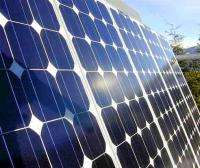January 2, 2013 weblog
Researchers receive $2.4 million ARPA-E grant to improve solar cell efficiency

(Phys.org)—Researchers at the California Institute of Technology have received a $2.4 million grant from the U.S. Advanced Research Projects Agency for Energy (ARPA-E) to study the feasibility of using a new technique to capture more energy from sunlight. The grant is based on work described by Caltech's Harry Atwater and Albert Polman in a paper they've had published in the journal Nature Materials.
Most solar panels in use today follow a sandwich approach where layers of photovoltaic semiconductors are stacked – each is designed to get the most energy from a specific wavelength range. The problem with this approach is that the layer with the lowest current limits the amount of electricity that can be generated. Because of this, efficiency levels for current solar cells is below 20 percent. To get around this problem, Atwater and colleagues suggest an alternative approach that allows for separating as many as eight to ten of the colors in the light spectrum and directing each to a solar cell designed for that particular wavelength.
The researchers suggest that technology involved in separating and directing different wavelengths of light has evolved to the point where it should now be feasible to create solar cells that not only are much more efficient – over 50 percent – but are every bit as inexpensive as those being sold today. As one example they note the progress that has been made with flat panel displays, which work by directing different wavelengths of light in very small (pixel sized) devices.
They suggest that by using precisely structured materials to sort sunlight into several different wavelengths, it should be possible to direct each to a semiconductor that has been tuned to be the most efficient for that wavelength. The end result should be the absorption of more energy overall, allowing for the generation of more electricity (and less heat) from the same amount of sunlight.
Their idea isn't completely new of course, many research centers have created solar cells using very similar ideas. What's new is the idea that advances in nanomaterials should allow for such cells to be mass produced in a way makes them cost effective – and that is what the team plans to use the grant money to discover.
More information: Reference: Nature Materials 11, 174–177 (2012) doi:10.1038/nmat3263
Journal information: Nature Materials
© 2013 Phys.org

















